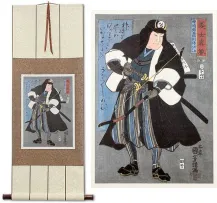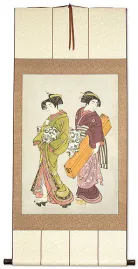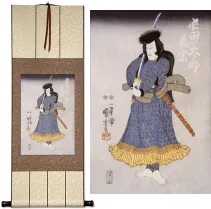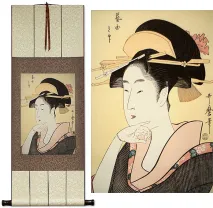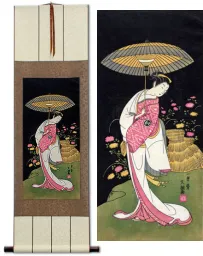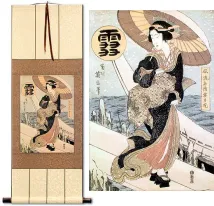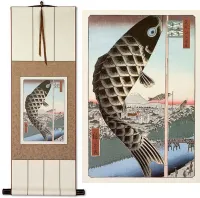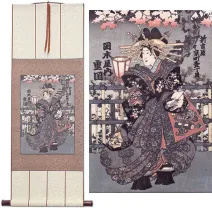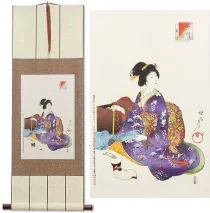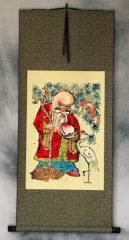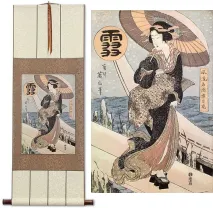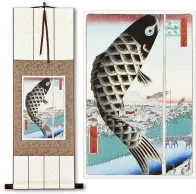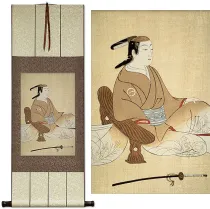Cherry Blossom
Sakura Bana
Woodblock Print Repro Wall Scroll

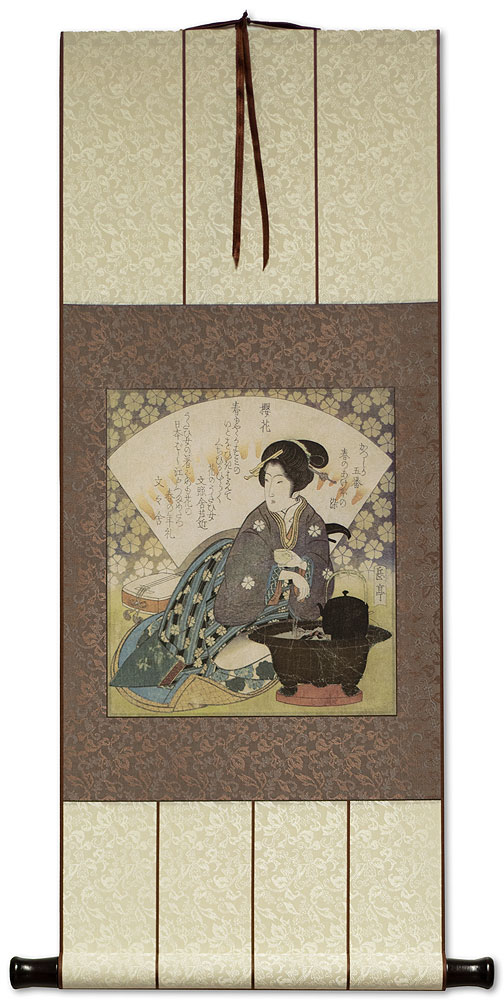
37"
18¼"
• Delivered to you in Columbus by Dec 26th.
• Standard shipping is just $3.80 for any order.
• 1 in stock now. Future supply uncertain.
• Fine Art Giclée Print.
• Handmade Wall Scroll.
• Money-Back Guarantee.

This artwork will look great in your home or office.
Approximate Measurements
Artwork Panel: 28.2cm x 32.3cm ≈ 11" x 12¾"
Silk/Brocade: 37.5cm x 94.3cm ≈ 14¾" x 37"
Width at Wooden Knobs: 46.5cm ≈ 18¼"
Information about caring for your wall scrollSee Larger Image


Cherry Blossom
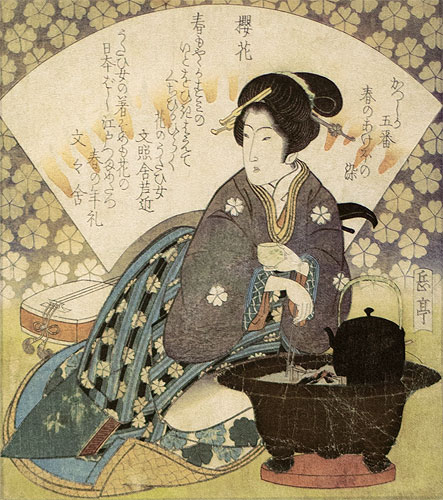
Close up view of the artwork mounted to this silk brocade wall scroll
This features a courtesan drinking tea. The clothing makes this image from the Edo period (1615–1868).
This was a woodblock print created by 八島岳亭 (Yashima Gakutei) back in about 1830. All of the prints were created so long ago that they all show a loss of detail and portions were clipped. I spent many hours working on the restoration of the image, but without removing all of the indications of age. You can now enjoy how this would have looked more than a century ago, but at a price, you can afford. I also cheated a little, as the original was a little over 8" (20cm) wide. Mine is almost 30% wider, so it makes a better presentation on your wall.
On the right, you will see the artist's given name, 岳亭 (Gakutei), written vertically, in black characters.
The artist is believed to be the illegitimate son of Samura Hirata under the Totugawa Shogunate. His mother later married into the Yashima Clan, thus the artist taking the surname Yashima. The artist was born around 1786 and died in 1868 at the ripe old age of 82.
The text at the upper right reads, "かつしか五番 春のあけほの染", which indicates this is from the series "A Set of Five Designs for the Katsushika Group: Textiles Dyed the Colors of Spring Dawn".
In the middle top is the title 櫻花 which means Sakura, often written Sakurabana. In modern Japan, this is written in reformed characters as 桜花. The meaning is "Cherry Blossoms".
At the top left, there is a poem that reads, 春もやゝ かすミのいとを ひきはえて くちひるひらく 花のうたひ女 文照舎芦近
うたひ女の 着そめも 花の日本ばし 江戸つまめたつ 春の年礼 文々舎.
At the end, the poet's name is written "文々舎" (Bunbunsha).
This poem is hard to translate, it's about springtime and blossoming flowers, a beauty dressed or dressing in floral patterns, etc. It's beyond my ability since Japanese is a second language for me.
About Real Japanese Woodblock Prints
Woodblock printing, often considered the precursor to the modern printing press, was first developed in China and later brought to Japan, where artists refined the technique into a unique art form. In Japan, these prints are called 木版畫 ("Moku Hanga"). Most were created during the Edo period (1603–1867), though production continued into the early 20th century.
Japanese artists would first create a "template painting" depicting scenes of daily life, including women washing clothes, men writing poetry, samurai battles, and occasionally more dramatic subjects. These template images, known as 浮世絵 (Ukiyo-e, or "Floating World"), were then carved into wood by skilled artisans. Another specialist applied wet ink or pigments to the carved blocks, and a sheet of handmade paper was pressed on to create the final print. This collaborative process produced vibrant, detailed artworks much faster than hand-painting hundreds of copies.
About This Reproduction
Original Japanese woodblock prints from the Edo period can sell for $800 to $20,000. Our prints are high-quality reproductions, crafted to capture the look and feel of the originals, though experts will recognize them as reproductions.
We use authentic handmade kozo (mulberry) paper—the same paper Japanese printmakers used centuries ago. Archival, UV-resistant pigment inks ensure long-lasting color, with laboratory testing showing up to 95 years of fade-free enjoyment if kept out of direct sunlight. Each reproduction is carefully color-corrected and restored, bringing the Edo period artwork to life for your wall.
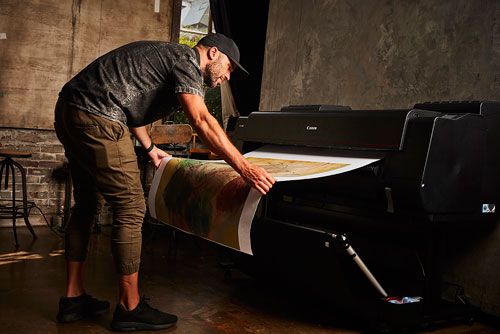
Photographer Jeremy Cowart and the Canon imagePROGRAF PRO-2000 giclée printer used to create these reproductions.
Printing on delicate handmade paper is challenging. After testing multiple high-end printers, we found the Canon imagePROGRAF PRO-2000 delivers the precision and quality needed, using 12 archival inks and 18,432 nozzles. Each print is then sent to our Beijing workshop, where it is mounted into a handmade wall scroll, ready-to-hang without the need for expensive framing, giving your piece an authentic Japanese look.
Because the original artist has long passed, these works are public domain. In some cases, we license high-resolution scans of original prints, or even scan 200-year-old originals ourselves. This dedication ensures you receive a stunning Japanese woodblock print reproduction at an affordable price, making traditional Asian art accessible to everyone.
Want a custom wall scroll or unique print size? Just contact us!
We can print larger sizes, choose your preferred paper texture, and select silk brocade colors. Ready-to-frame prints can ship in days, while custom wall scrolls may take several weeks. Either way, the result is a truly one-of-a-kind piece of Japanese art.
This item was listed or modified
Dec 7th, 2022
